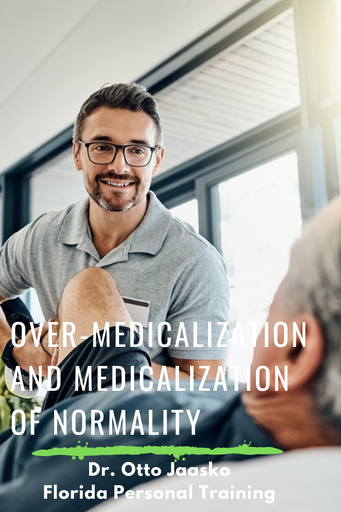What is over-medicalization and medicalization of normality?
Over-medicalization, like the name suggests, refers to excessive use of medical diagnostics and procedures for conditions and complaints that don’t warrant such cost- and time- intensive practices. Many conditions and complaints, especially those of neuromusculoskeletal nature, have more efficient, cheaper, and safer alternatives available. Overuse of medical diagnostics and procedures has become a significant problem in the United States as it leads to increased expenses, takes away from patient ownership of managing neuromusculoskeletal conditions, and often has outcomes indifferent or worse than other options such as movement therapy.
Examples of over-medicalization can be magnetic resonance imaging (MRI) for non-specific low back pain, arthroscopies for non-traumatic knee pain, shoulder joint debridement for shoulder pain, surgical procedures for bone spurs, et cetera. In cases such as these, surgical intervention can induce a certain risk to the patient, debilitate the patient following the surgery, reduce the patient’s role in the rehabilitation process, and most importantly often yield no better outcomes than movement therapy. Additionally, the movement dysfunction that is commonly present, does not get addressed. It is a simple “fix” that is often not as effective as conservative treatment options.
Medicalization of normality refers to the practice of attempting to explain pain and complaints through structural findings and pathoanatomical characteristics. In other words, attempting to find the exact cause of the pain and complaints, which the research suggests being inefficient and, in many cases, correlated to non-favorable outcomes. An example of medicalization of normality include utilization of MRIs for low back pain to explain pain and complaints and considering low back pain as “abnormal”. It is estimated in the literature that ~90% of the individuals experience low back pain and one may argue that experiencing low back pain is more normal than abnormal statistically speaking. Medicalizing low back pain among many other types of pain (neck pain, knee pain, hip pain, etc.) can lead to fear behaviors (fear of movement, fear of structural fragility, etc.), non-favorable cognitions about pain, and concerns for the patient associating pain with something being significantly wrong with them. We know that this is not true, as most cases of low back pain, for example, have a natural course of recovery between 2-3 weeks without any imaging/treatment. When adding movement therapy into the mix, the recovery is typically extremely favorable without any medical diagnostics or procedures. Another example of medicalizing normality could be the attempt of associating posture to pain. The literature shows that large variability exists in postures between individuals, and no associations have been made between posture and complaints of pain.
What can you do to prevent falling victim of over-medicalization?
Advocate for yourself
When interacting with medical professionals who are involved in your care, be active and advocate for yourself to prevent over-medicalization and medicalization of normality. Ask your providers for all possible options, including conservative (non-surgical, non-pharmacological, movement therapy, etc.) treatment options, even simply waiting to see what happens. Ask for associated risks, value, and outcomes associated with diagnostics and procedures such as MRIs, orthoscopies, and many others. What will the proposed treatment approach cost? What will it do for you? What is the likelihood it will
help? How long will it take for it to help? Will the effects last? Are there alternatives available that will allow for better outcomes? Your provider should be able to answer with unbiased information for him or her to be worth your time. Lastly and possibly most importantly, ask how YOU can help take care of your problem. Taking ownership over your complaints is often overlooked and under-emphasized by healthcare providers. Being a central part of your own healthcare is essential and often extremely valuable to improve the quality of your life.
See a Physical Therapist first
When you experience pain or movement dysfunction in your body, consider seeing a Doctor of Physical Therapy (PT) first. PTs are trained in medical system screening procedures that ensure you are safe for further assessment and treatment by movement system therapy. For example, if you have twisted your ankle, the PT applying the Ottawa Ankle Rules can effectively rule out a fracture when appropriate and therefore prevent excessive health care provider visits, imaging, and procedures when not needed. From there, the PT can initiate appropriate therapy practice to initiate treatment right away without time, effort, or money wasted. Such practice applies to most movement system related pains and complaints with the exception of medical emergencies.
Sincerely,
Dr. Nils-Otto Jaasko, DPT, ATC





